Secara umum jagung mempunyai pola pertumbuhan yang sama, namun interval waktu antartahap pertumbuhan dan jumlah daun yang berkembang dapat berbeda. Pertumbuhan jagung dapat dikelompokkan ke dalam tiga tahap yaitu (1) fase perkecambahan, saat proses imbibisi air yang ditandai dengan pembengkakan biji sampai dengan sebelum munculnya daun pertama; (2) fase pertumbuhan vegetatif, yaitu fase mulai munculnya daun pertama yang terbuka sempurna sampai tasseling dan sebelum keluarnya bunga betina (silking), fase ini diidentifiksi dengan jumlah daun yang terbentuk; dan (3) fase reproduktif, yaitu fase pertumbuhan setelah silking sampai masak fisiologis.
Perkecambahan benih jagung terjadi ketika radikula muncul dari kulit biji. Benih jagung akan berkecambah jika kadar air benih pada saat di dalam tanah meningkat >30% (McWilliams et al. 1999). Proses perkecambahan benih jagung, mula-mula benih menyerap air melalui proses imbibisi dan benih membengkak yang diikuti oleh kenaikan aktivitas enzim dan respirasi yang tinggi. Perubahan awal sebagian besar adalah katabolisme pati, lemak, dan protein yang tersimpan dihidrolisis menjadi zat-zat yang mobil, gula, asam-asam lemak, dan asam amino yang dapat diangkut ke bagian embrio yang tumbuh aktif. Pada awal perkecambahan, koleoriza memanjang menembus pericarp, kemudian radikel menembus koleoriza. Setelah radikelmuncul, kemudian empat akar seminal lateral juga muncul. Pada waktu yang sama atau sesaat kemudian plumule tertutupi oleh koleoptil. Koleoptil terdorong ke atas oleh pemanjangan mesokotil, yang mendorong koleoptil ke permukaan tanah. Mesokotil berperan penting dalam pemunculan kecambah ke atas tanah. Ketika ujung koleoptil muncul ke luar permukaan tanah, pemanjangan mesokotil terhenti dan plumul muncul dari koleoptil dan menembus permukaan tanah.

Benih jagung umumnya ditanam pada kedalaman 5-8 cm. Bila kelembaban tepat, pemunculan kecambah seragam dalam 4-5 hari setelah tanam. Semakin dalam lubang tanam semakin lama pemunculan kecambah ke atas permukaan tanah. Pada kondisi lingkungan yang lembab, tahap pemunculan berlangsung 4-5 hari setelah tanam, namun pada kondisi yang dingin atau kering, pemunculan tanaman dapat berlangsung hingga dua minggu setelah tanam atau lebih.
Keseragaman perkecambahan sangat penting untuk mendapatkan hasil yang tinggi. Perkecambahan tidak seragam jika daya tumbuh benih rendah. Tanaman yang terlambat tumbuh akan ternaungi dan gulma lebih bersaing dengan tanaman, akibatnya tanaman yang terlambat tumbuh tidak normal dan tongkolnya relatif lebih kecil dibanding tanaman yang tumbuh lebih awal dan seragam.
Setelah perkecambahan, pertumbuhan jagung melewati beberapa fase berikut:
Fase V3-V5 (jumlah daun yang terbuka sempurna 3-5)
Fase ini berlangsung pada saat tanaman berumur antara 10-18 hari setelah berkecambah. Pada fase ini akar seminal sudah mulai berhenti tumbuh, akar nodul sudah mulai aktif, dan titik tumbuh di bawah permukaan tanah. Suhu tanah sangat mempengaruhi titik tumbuh. Suhu rendah akan memperlambat keluar daun, meningkatkan jumlah daun, dan menunda terbentuknya bunga jantan (McWilliams et al. 1999).
Fase V6-V10 (jumlah daun terbuka sempurna 6-10)
Fase ini berlangsung pada saat tanaman berumur antara 18 -35 hari setelah berkecambah. Titik tumbuh sudah di atas permukaan tanah, perkembangan akar dan penyebarannya di tanah sangat cepat, dan pemanjangan batang meningkat dengan cepat. Pada fase ini bakal bunga jantan (tassel) dan perkembangan tongkol dimulai (Lee 2007). Tanaman mulai menyerap hara dalam jumlah yang lebih banyak, karena itu pemupukan pada fase ini diperlukan untuk mencukupi kebutuhan hara bagi tanaman (McWilliams et al. 1999).

Fase V11- Vn (jumlah daun terbuka sempurna 11 sampai daun terakhir 15-18)
Fase ini berlangsung pada saat tanaman berumur antara 33-50 hari setelah berkecambah. Tanaman tumbuh dengan cepat dan akumulasi bahan kering meningkat dengan cepat pula. Kebutuhan hara dan air relatif sangat tinggi untuk mendukung laju pertumbuhan tanaman. Tanaman sangat sensitif terhadap cekaman kekeringan dan kekurangan hara. Pada fase ini, kekeringan dan kekurangan hara sangat berpengaruh terhadap pertumbuhan dan perkembangan tongkol, dan bahkan akan menurunkan jumlah biji dalam satu tongkol karena mengecilnya tongkol, yang akibatnya menurunkan hasil (McWilliams et al. 1999, Lee 2007). Kekeringan pada fase ini juga akan memperlambat munculnya bunga betina (silking).
Fase Tasseling / VT (berbunga jantan)
Fase tasseling biasanya berkisar antara 45-52 hari, ditandai oleh adanya cabang terakhir dari bunga jantan sebelum kemunculan bunga betina (silk/rambut tongkol). Tahap VT dimulai 2-3 hari sebelum rambut tongkol muncul, di mana pada periode ini tinggi tanaman hampir mencapai maksimum dan mulai menyebarkan serbuk sari (pollen). Pada fase ini dihasilkan biomas maksimum dari bagian vegetatif tanaman, yaitu sekitar 50% dari total bobot kering tanaman, penyerapan N, P, dan K oleh tanaman masing-masing 60-70%, 50%, dan 80-90%.
Fase R1 (silking)
Tahap silking diawali oleh munculnya rambut dari dalam tongkol yang terbungkus kelobot, biasanya mulai 2-3 hari setelah tasseling. Penyerbukan (polinasi) terjadi ketika serbuk sari yang dilepas oleh bunga jantan jatuh menyentuh permukaan rambut tongkol yang masih segar. Serbuk sari tersebut membutuhkan waktu sekitar 24 jam untuk mencapai sel telur (ovule), di mana pembuahan (fertilization) akan berlangsung membentuk bakal biji. Rambut tongkol muncul dan siap diserbuki selama 2-3 hari. Rambut tongkol tumbuh memanjang 2,5-3,8 cm/hari dan akan terus memanjang hingga diserbuki. Bakal biji hasil pembuahan tumbuh dalam suatu struktur tongkol dengan dilindungi oleh tiga bagian penting biji, yaitu glume, lemma, dan palea, serta memiliki warna putih pada bagian luar biji. Bagian dalam biji berwarna bening dan mengandung sangat sedikit cairan. Pada tahap ini, apabila biji dibelah dengan menggunakan silet, belum terlihat
struktur embrio di dalamnya. Serapan N dan P sangat cepat, dan K hampir komplit (Lee 2007).
Fase R2 (blister)
Fase R2 muncul sekitar 10-14 hari seletelah silking, rambut tongkol sudah kering dan berwarna gelap. Ukuran tongkol, kelobot, dan janggel hampir sempurna, biji sudah mulai nampak dan berwarna putih melepuh, pati mulai diakumulasi ke endosperm, kadar air biji sekitar 85%, dan akan menurun terus sampai panen.
Fase R3 (masak susu)
Fase ini terbentuk 18 -22 hari setelah silking. Pengisian biji semula dalam bentuk cairan bening, berubah seperti susu. Akumulasi pati pada setiap biji sangat cepat, warna biji sudah mulai terlihat (bergantung pada warna biji setiap varietas), dan bagian sel pada endosperm sudah terbentuk lengkap. Kekeringan pada fase R1-R3 menurunkan ukuran dan jumlah biji yang terbentuk. Kadar air biji dapat mencapai 80%.
Fase R4 (dough)
Fase R4 mulai terjadi 24-28 hari setelah silking. Bagian dalam biji seperti pasta (belum mengeras). Separuh dari akumulasi bahan kering biji sudah terbentuk, dan kadar air biji menurun menjadi sekitar 70%. Cekaman kekeringan pada fase ini berpengaruh terhadap bobot biji.
Fase R5 (pengerasan biji)
Fase R5 akan terbentuk 35-42 hari setelah silking. Seluruh biji sudah terbentuk sempurna, embrio sudah masak, dan akumulasi bahan kering biji akan segera terhenti. Kadar air biji 55%.
Fase R6 (masak fisiologis)
Tanaman jagung memasuki tahap masak fisiologis 55-65 hari setelah silking. Pada tahap ini, biji-biji pada tongkol telah mencapai bobot kering maksimum. Lapisan pati yang keras pada biji telah berkembang dengan sempurna dan telah terbentuk pula lapisan absisi berwarna coklat atau kehitaman. Pembentukan lapisan hitam (black layer) berlangsung secara bertahap, dimulai dari biji pada bagian pangkal tongkol menuju ke bagian ujung tongkol. Pada varietas hibrida, tanaman yang mempunyai sifat tetap hijau (stay-green) yang tinggi, kelobot dan daun bagian atas masih berwarna hijau meskipun telah memasuki tahap masak fisiologis. Pada tahap ini kadar air biji berkisar 30-35% dengan total bobot kering dan penyerapan NPK oleh tanaman mencapai masing-masing 100%.
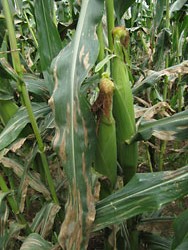
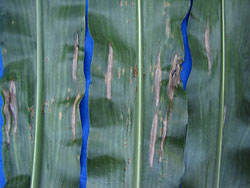

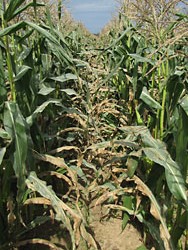
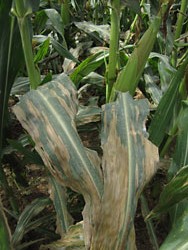
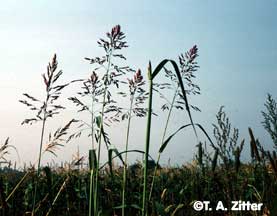
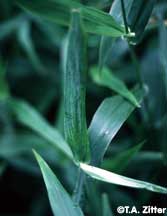
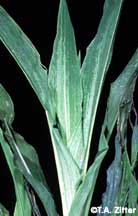
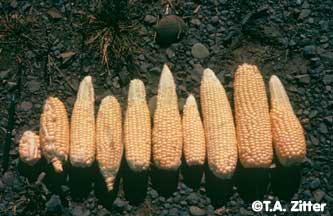
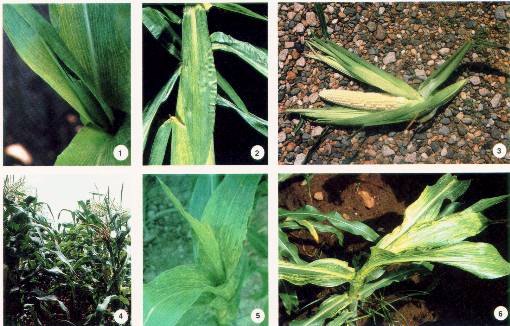
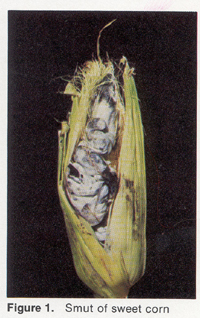
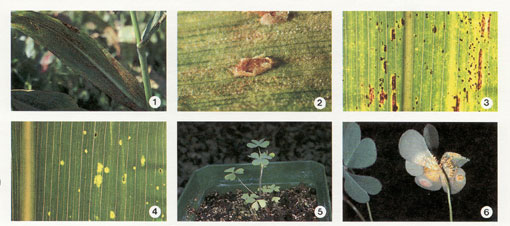
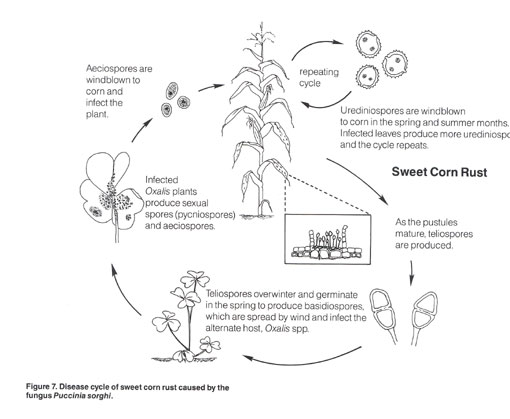
 Soil
insects, primarily wireworms and white grubs, can cause stand reduction
or stunted plants. These insects should be considered a serious
threat when corn will be planted in ground immediately following sod. A
preplant treatment may be considered. However, it is likely that a
planting-time treatment will provide sufficient protection.
Soil
insects, primarily wireworms and white grubs, can cause stand reduction
or stunted plants. These insects should be considered a serious
threat when corn will be planted in ground immediately following sod. A
preplant treatment may be considered. However, it is likely that a
planting-time treatment will provide sufficient protection.  Soil
insect problems generally decrease with time out of sod. Problems with
white grubs may occur in soils fertilized heavily with compost or
manure. Rootworms may cause damage in ground where corn is grown every
year. Soil insecticides will generally greatly reduce troubles with
these pests.
Soil
insect problems generally decrease with time out of sod. Problems with
white grubs may occur in soils fertilized heavily with compost or
manure. Rootworms may cause damage in ground where corn is grown every
year. Soil insecticides will generally greatly reduce troubles with
these pests.  Cutworms
Cutworms Flea
beetles are small, black, hard-bodied insects that hop or fly quickly
when disturbed. They overwinter as adults and become active early in the
spring.
Flea
beetles are small, black, hard-bodied insects that hop or fly quickly
when disturbed. They overwinter as adults and become active early in the
spring. The
real concern from flea beetles is Stewart's wilt, a bacterial disease
of corn. The pathogen is carried inside the flea beetle. Young plants
become infected as the beetles feed. Damage from Stewart's wilt is far
more severe than leaf injury caused by the beetles. Wilt resistant
sweet corn varieties should be selected to prevent losses. Chemical
control of the beetle should not be the only protection program for
Stewart's wilt.
The
real concern from flea beetles is Stewart's wilt, a bacterial disease
of corn. The pathogen is carried inside the flea beetle. Young plants
become infected as the beetles feed. Damage from Stewart's wilt is far
more severe than leaf injury caused by the beetles. Wilt resistant
sweet corn varieties should be selected to prevent losses. Chemical
control of the beetle should not be the only protection program for
Stewart's wilt.  European Corn Borer
European Corn Borer The
first generation is most vulnerable to chemical control. Treatment
should be considered if "shot-hole" damage is apparent on 25% of the
plants and live larvae are present in the whorls. One application should
be sufficient against the first generation. Your county agent for
agriculture can give you accurate information on when to expect damage.
Treatment applied after borers have entered the plant will not be
effective.
The
first generation is most vulnerable to chemical control. Treatment
should be considered if "shot-hole" damage is apparent on 25% of the
plants and live larvae are present in the whorls. One application should
be sufficient against the first generation. Your county agent for
agriculture can give you accurate information on when to expect damage.
Treatment applied after borers have entered the plant will not be
effective.  Fall Armyworm
Fall Armyworm Fall
armyworms are smooth and green to black with three thin yellow lines
down the back. A dark stripe and a wavy yellow stripe runs along each
side. Larvae have a dark head with a white inverted "Y".
Fall
armyworms are smooth and green to black with three thin yellow lines
down the back. A dark stripe and a wavy yellow stripe runs along each
side. Larvae have a dark head with a white inverted "Y". The
corn earworm is the most serious sweet corn pest because it feeds
directly on the market product. Once worms have become established
within the ear, control is impossible.
The
corn earworm is the most serious sweet corn pest because it feeds
directly on the market product. Once worms have become established
within the ear, control is impossible. Sap Beetles
Sap Beetles Silk Clipping Insects
Silk Clipping Insects